Restriction of Rift Valley Fever Virus Virulence in Mosquito Cells
Abstract
:1. Introduction
2. Results
2.1. RVF Virus Can Productively Infect Vertebrate and Arthropod Cells
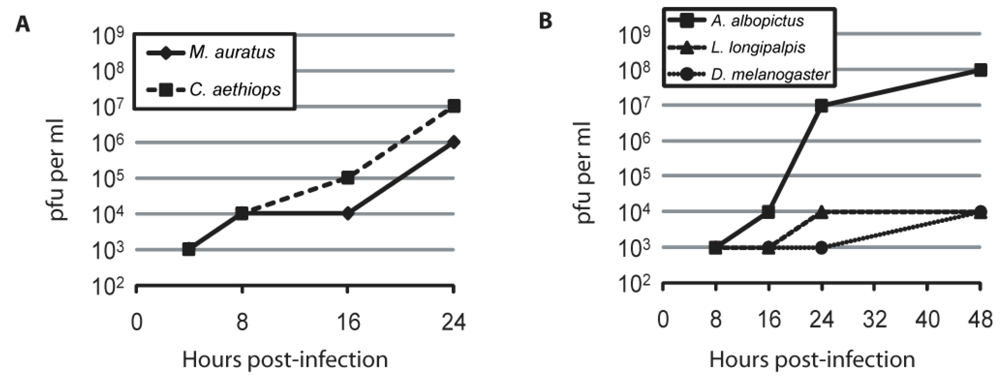
2.2. Kinetics of RVF Virus Structural Protein Expression
| HPI | Source Specie (Cell Line) | Total Cells | % Infected* | % Infected expressing Gn |
|---|---|---|---|---|
| 8 | M. auratus (BSR-T7/5) | 393 | 85.0% | 89.8% |
| 16 | 790 | 99.1% | 99.5% | |
| 24 | 365 | 99.5% | 100% | |
| 48† | ||||
| 8 | C. aethiops (Vero E6) | 609 | 83.1% | 92.7% |
| 16 | 344 | 96.5% | 100% | |
| 24 | 295 | 97.3% | 100% | |
| 48† | ||||
| 8 | A. albopictus (C6/36) | 529 | 97.9% | 51.4% |
| 16 | 655 | 98.0% | 63.1% | |
| 24 | 380 | 96.3% | 87.7% | |
| 48 | 547 | 96.3% | 76.5% | |
| 8 | L. longipalpis (LL-5) | n.d. | n.d. | n.d. |
| 16 | 69 | 100% | 92.0% | |
| HPI | Source Specie (Cell Line) | Total Cells | % Infected* | % Infected expressing Gn |
| 24 | 114 | 99.1% | 99.1% | |
| 48 | 193 | 97.9% | 85.7% | |
| 8 | D. melanogaster (S2) | n.d. | n.d. | n.d. |
| 16 | 229 | 93.0% | 91.5% | |
| 24 | 272 | 98.5% | 96.3% | |
| 48 | 97 | 92.8% | 85% |
2.3. NSs Is Expressed at Very Low Levels in Arthropod Cell Lines
2.4. NSs is Not Detected in Mosquito Cells by Immunoprecipitation

| HPI | Source Specie (Cell Line) | Total Cells | % Infected | % Infected expressing NSs |
|---|---|---|---|---|
| 8 | M. auratus (BSR-T7/5) | 398 | 90.2% | 66.9% |
| 16 | 577 | 100% | 88.4% | |
| 24 | 855 | 100% | 92.7% | |
| HPI | Source Specie (Cell Line) | Total Cells | % Infected | % Infected expressing NSs |
| 48† | ||||
| 8 | C. aethiops (Vero E6) | 324 | 90.1% | 69.9% |
| 16 | 309 | 98.7% | 86.2% | |
| 24 | 418 | 98.1% | 89.8% | |
| 48† | ||||
| 8 | A. albopictus (C6/36) | 378 | 97.4% | 0.272%‡ |
| 16 | 482 | 96.1% | 0.648%‡ | |
| 24 | 393 | 95.4% | 1.07%‡ | |
| 48 | 328 | 91.2% | 0.669%‡ | |
| 8 | L. longipalpis (LL-5) | 138 | 71.7% | 2.02%‡ |
| 16 | 104 | 98.1% | 1.96%‡ | |
| 24 | 227 | 94.7% | 0.465%‡ | |
| 48 | 189 | 95.2% | 1.11%‡ | |
| 8 | D. melanogaster (S2) | n.d. | n.d. | n.d. |
| 16 | 288 | 95.1% | 0.00%‡ | |
| 24 | 279 | 92.8% | 0.00%‡ | |
| 48 | 83 | 100% | 0.00%‡ |
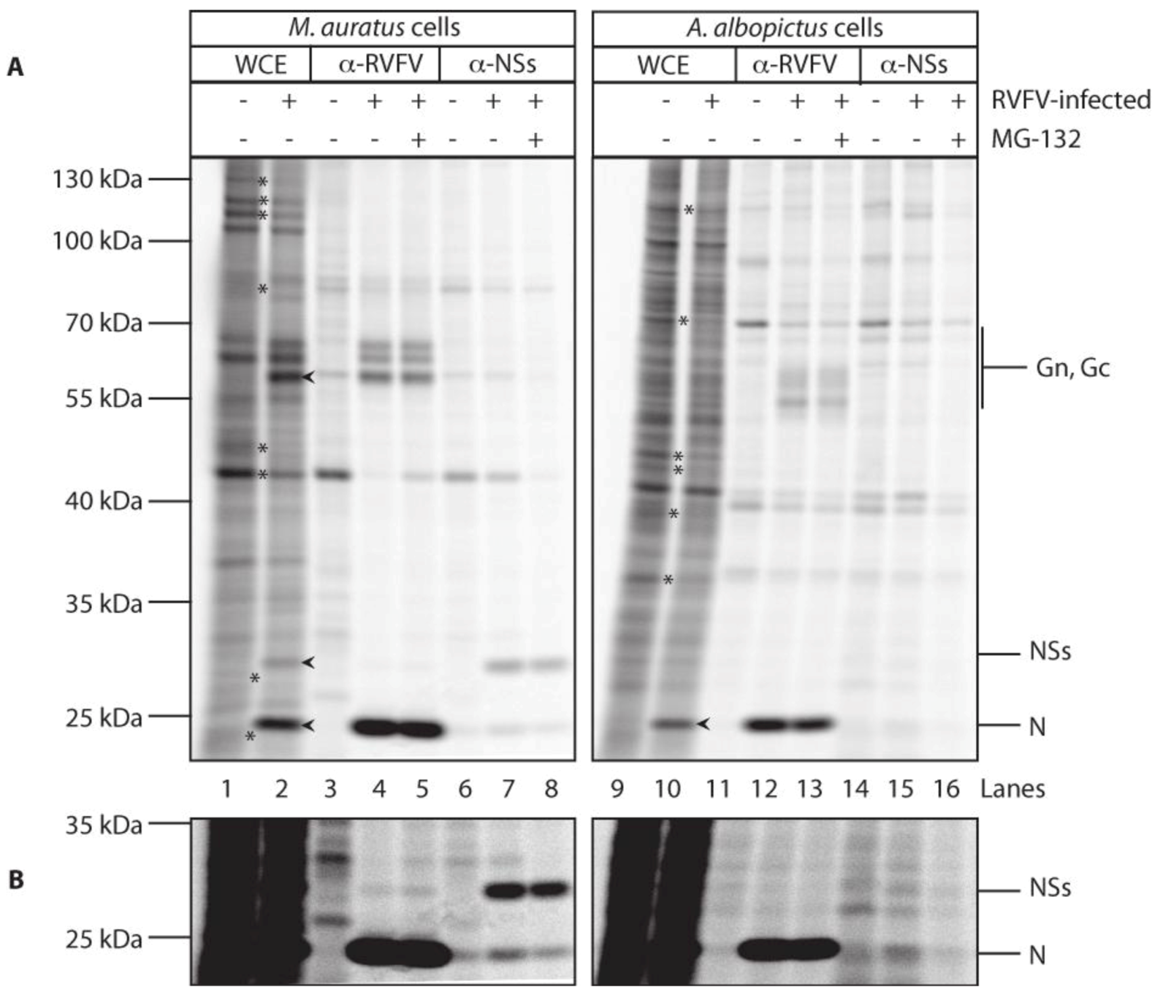
2.5. NSs Expression is Not Temperature-Sensitive
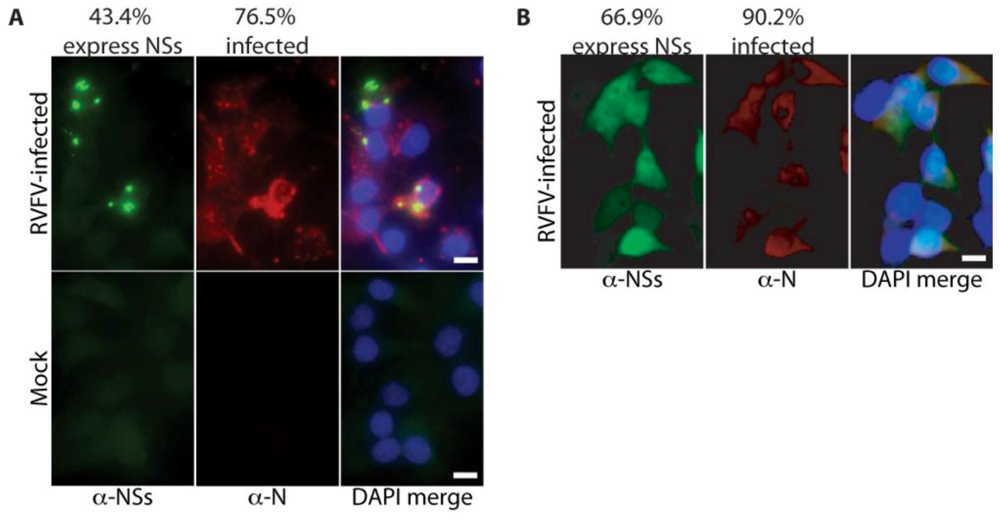
2.6. Plasmid-Expressed NSs in Mosquito and Fruitfly Cells Accumulates in the Nucleus
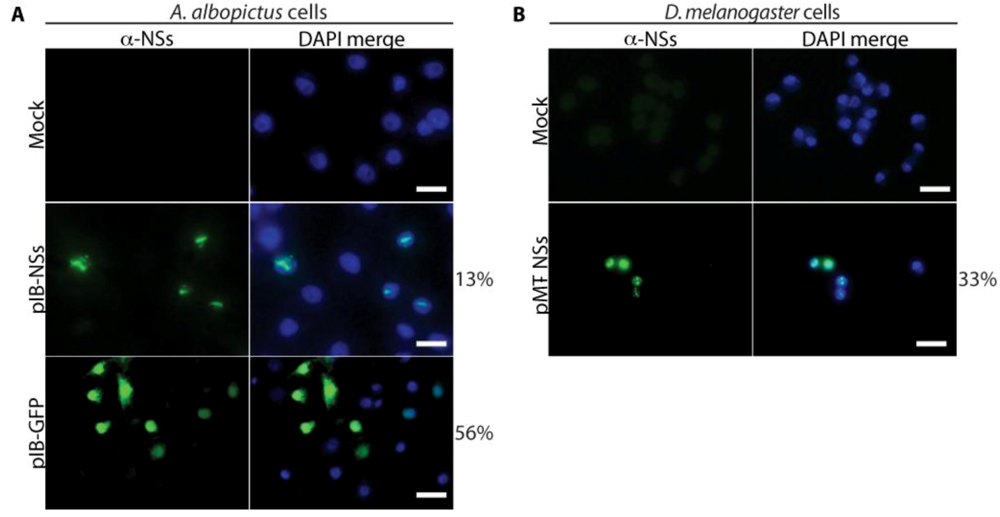
2.7. Plasmid-Expressed NSs Inhibits Reporter Gene Expression in Fruitfly Cells
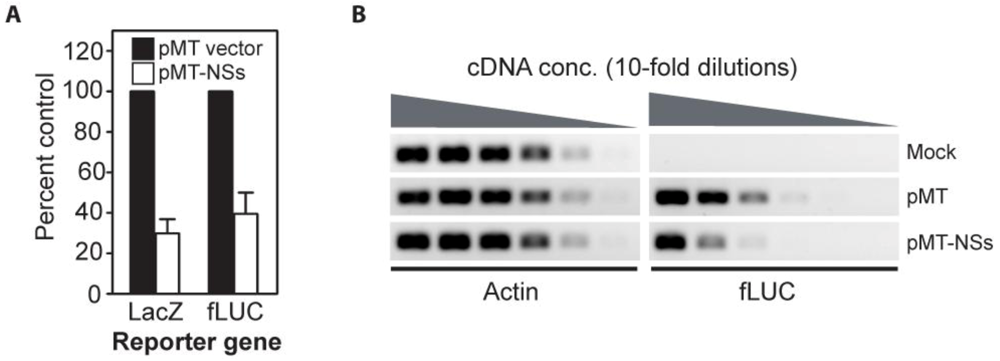
2.8. Discussion
3. Experimental Section
3.1. Cells and Virus
3.2. Antibodies
3.3. Construction of pIB-GFP, pIB-NSs and pMT-NSs
3.4. Plasmids and Transfection
3.5. Infections and Virus Titration
3.6. Quantification of Indirect Immunofluorescence Microscopy Data
3.7. Intensity Quantification of NSs Expression
3.8. Radioactive Immune-Precipitation Assay
3.9. Reporter Gene Expression
4. Conclusions
Acknowledgments
References
- Nichol, S.T. Bunyaviruses . Fields, B.N., Knipe, D.M., Howley, P.M., Griffin, D.E., Eds.; Lippincott Williams & Wilkins: Philadelphia, PA, USA, 2001; pp. 1603–1633. [Google Scholar]
- Easterday, B.C. Rift Valley Fever. Adv. Vet. Sci. 1965, 10, 65–127. [Google Scholar] [PubMed]
- Linthicum, K.J.; Davies, F.G.; Kairo, A.; Bailey, C.L. Rift Valley Fever virus (family Bunyaviridae, genus Phlebovirus) Isolations from Diptera Collected During an Inter-Epizootic Period in Kenya. J. Hyg. (Lond.) 1985, 95, 197–209. [Google Scholar] [CrossRef] [PubMed]
- Davies, F.G.; Linthicum, K.J.; James, A.D. Rainfall and Epizootic Rift Valley Fever. Bull. World Health Organ. 1985, 63, 941–943. [Google Scholar] [PubMed]
- Linthicum, K.J.; Anyamba, A.; Tucker, C.J.; Kelley, P.W.; Myers, M.F.; Peters, C.J. Climate and Satellite Indicators to Forecast Rift Valley Fever Epidemics in Kenya. Science 1999, 285, 397–400. [Google Scholar] [CrossRef] [PubMed]
- Anyamba, A.; Chretien, J.P.; Small, J.; Tucker, C.J.; Formenty, P.B.; Richardson, J.H.; Britch, S.C.; Schnabel, D.C.; Erickson, R.L.; Linthicum, K.J. Prediction of a Rift Valley Fever Outbreak. Proc. Natl. Acad. Sci. USA 2009, 106, 955–959. [Google Scholar] [CrossRef]
- Hoogstraal, H.; Meegan, J.M.; Khalil,G.M.; Adham, F.K. The Rift Valley Fever Epizootic in Egypt 1977â78. 2. Ecological and Entomological Studies . Trans. R. Soc. Trop. Med. Hyg. 1979, 73, 624–629. [Google Scholar] [CrossRef] [PubMed]
- Tourre, Y.M.; Lacaux, J.P.; Vignolles, C.; Ndione,J.A.; Lafaye, M. Mapping of Zones Potentially Occupied by Aedes vexans and Culex poicilipes Mosquitoes, the Main Vectors of Rift Valley Fever in Senegal. Geospat . Health 2008, 3, 69–79. [Google Scholar]
- Turell, M.J.; Linthicum, K.J.; Patrican, L.A.; Davies, F.G.; Kairo, A.; Bailey, C.L. Vector Competence of Selected African Mosquito (Diptera: Culicidae) Species for Rift Valley Fever Virus. J. Med. Entomol. 2008, 45, 102–108. [Google Scholar] [CrossRef] [PubMed]
- Woodring, J.L.; Higgs, S.; Beaty, B.J. Natural cycles of vector-borne pathogens. Beaty, B.J., Marquardt, W.C., Eds.; University Press of Colorado: Niwot, CO, USA, 1996; pp. 51–72. [Google Scholar]
- Faran, M.E.; Turell, M.J.; Romoser, W.S.; Routier, R.G.; Gibbs, P.H.; Cannon, T.L.; Bailey, C.L. Reduced Survival of Adult Culex pipiens Infected with Rift Valley Fever Virus. Am. J. Trop. Med. Hyg. 1987, 37, 403–409. [Google Scholar] [PubMed]
- Turell, M.J.; Gargan, T.P.; Bailey, C.L. Culex pipiens (diptera: Culicidae) Morbidity and Mortality Associated With Rift Valley Fever Virus Infection. J. Med. Entomol. 1985, 22, 332–337. [Google Scholar] [PubMed]
- Schmaljohn, C.S.; Hooper, J.W. Bunyaviridae: The Viruses and Their Replication . Fields, B.N., Knipe, D.M., Howley, P.M., Griffin, D.E., Eds.; Lippincott Williams & Wilkins: Philadelphia, PA, USA, 2001; pp. 1581–1602. [Google Scholar]
- Le May, N.; Dubaele, S.; Proietti De Santis, L.; Billecocq, A.; Bouloy, M.; Egly, J.M. TFIIH Transcription Factor, a Target for the Rift Valley Hemorrhagic Fever Virus. Cell 2004, 116, 541–550. [Google Scholar] [CrossRef] [PubMed]
- Billecocq, A.; Spiegel, M.; Vialat, P.; Kohl, A.; Weber, F.; Bouloy, M.; Haller, O. NSs Protein of Rift Valley Fever Virus Blocks Interferon Production by Inhibiting Host Gene Transcription. J. Virol. 2004, 78, 9798–9806. [Google Scholar] [CrossRef] [PubMed]
- Le May, N.; Mansuroglu, Z.; Leger, P.; Josse, T.; Blot, G.; Billecocq, A.; Flick, R.; Jacob, Y.; Bonnefoy, E.; Bouloy, M. A SAP30 Complex Inhibits IFN-Beta Expression in Rift Valley Fever Virus Infected Cells . PLoS Pathog. 2008, 4, e13. [Google Scholar] [CrossRef] [PubMed]
- Habjan, M.; Pichlmair, A.; Elliott, R.M.; Overby, A.K.; Glatter, T.; Gstaiger, M.; Superti-Furga, G.; Unger, H.; Weber, F. NSs Protein of Rift Valley Fever Virus Induces the Specific Degradation of the Double-Stranded RNA-Dependent Protein Kinase (PKR). J. Virol. 2009, 83, 4365–4375. [Google Scholar] [CrossRef] [PubMed]
- Ikegami, T.; Narayanan, K.; Won, S.; Kamitani, W.; Peters, C.J.; Makino, S. Rift Valley Fever Virus NSs Protein Promotes Post-Transcriptional Downregulation of Protein Kinase PKR and Inhibits eIF2alpha Phosphorylation . PLoS Pathog. 2009, 5, e1000287. [Google Scholar] [CrossRef] [PubMed]
- Buchholz, U.J.; Finke, S.; Conzelmann, K.K. Generation of Bovine Respiratory Syncytial Virus (BRSV) from cDNA: BRSV NS2 is Not Essential for Virus Replication in Tissue Culture, and the Human RSV Leader Region Acts as a Functional BRSV Genome Promoter. J. Virol. 1999, 73, 251–259. [Google Scholar] [PubMed]
- Diaz, M.O.; Ziemin, S.; Le Beau, M.M.; Pitha, P.; Smith, S.D.; Chilcote, R.R.; Rowley, J.D. Homozygous Deletion of the Alpha- and Beta 1-Interferon Genes in Human Leukemia and Derived Cell Lines. Proc. Natl. Acad. Sci. USA 1988, 85, 5259–5263. [Google Scholar] [CrossRef]
- Igarashi, A. Isolation of a Singh's Aedes albopictus Cell Clone Sensitive to Dengue and Chikungunya Viruses. J. Gen. Virol. 1978, 40, 531–544. [Google Scholar] [CrossRef] [PubMed]
- Tesh, R.B.; Modi, G.B. Development of a Continuous Cell Line from the Sand Fly Lutzomyia longipalpis (Diptera: Psychodidae), and its Susceptibility to Infection with Arboviruses. J. Med. Entomol. 1983, 20, 199–202. [Google Scholar] [PubMed]
- Schneider, I. Cell Lines Derived from Late Embryonic Stages of Drosophila melanogaster. J. Embryol. Exp. Morphol. 1972, 27, 353–365. [Google Scholar] [PubMed]
- Moutailler, S.; Bouloy, M.; Failloux, A.B. Short Report: Efficient Oral Infection of Culex pipiens quinquefasciatus by Rift Valley Fever Virus using a Cotton Stick Support. Am. J. Trop. Med. Hyg. 2007, 76, 827–829. [Google Scholar] [PubMed]
- Turell, M.J.; Bailey, C.L.; Beaman, J.R. Vector Competence of a Houston, Texas Strain of Aedes albopictus for Rift Valley Fever Virus. J. Am. Mosq. Control Assoc. 1988, 4, 94–96. [Google Scholar] [PubMed]
- Hoch, A.L.; Turell, M.J.; Bailey, C.L. Replication of Rift Valley Fever Virus in the Sand Fly Lutzomyia longipalpis. Am. J. Trop. Med. Hyg. 1984, 33, 295–299. [Google Scholar] [PubMed]
- Kempf, B.J.; Blair, C.D.; Beaty, B.J. Quantitative Analysis of La Crosse Virus Transcription and Replication in Cell Cultures and Mosquitoes. Am. J. Trop. Med. Hyg. 2006, 74, 224–232. [Google Scholar] [PubMed]
- Newton, S.E.; Short, N.J.; Dalgarno, L. Bunyamwera Virus Replication in Cultured Aedes albopictus (Mosquito) Cells: Establishment of a Persistent Viral Infection. J. Virol. 1981, 38, 1015–1024. [Google Scholar] [PubMed]
- Elliott, R.M.; Wilkie, M.L. Persistent Infection of Aedes albopictus C6/36 Cells by Bunyamwera Virus. Virology 1986, 150, 21–32. [Google Scholar] [CrossRef] [PubMed]
- Carvalho, M.G.; Frugulhetti, I.C.; Rebello, M.A. Marituba (Bunyaviridae) Virus Replication in Cultured Aedes albopictus Cells and in L-A9 Cells. Arch. Virol. 1986, 90, 325–335. [Google Scholar] [CrossRef] [PubMed]
- Ellis, D.S.; Shirodaria, P.V.; Fleming, E.; Simpson, D.I. Morphology and Development of Rift Valley Fever Virus in Vero Cell Cultures. J. Med. Virol. 1988, 24, 161–174. [Google Scholar] [CrossRef] [PubMed]
- Yadani, F.Z.; Kohl, A.; Prehaud, C.; Billecocq, A.; Bouloy, M. The Carboxy-Terminal Acidic Domain of Rift Valley Fever Virus NSs Protein is Essential for the Formation of Filamentous Structures but Not for the Nuclear Localization of the Protein. J. Virol. 1999, 73, 5018–5025. [Google Scholar] [PubMed]
- Bouloy, M.; Janzen, C.; Vialat, P.; Khun, H.; Pavlovic, J.; Huerre, M.; Haller, O. Genetic Evidence for an Interferon-Antagonistic Function of Rift Valley Fever Virus Nonstructural Protein NSs. J. Virol. 2001, 75, 1371–1377. [Google Scholar] [CrossRef] [PubMed]
- M.archal, I.; Jarvis, D.L.; Cacan, R.; Verbert, A. Glycoproteins from Insect Cells: Sialylated Or Not? Biol. Chem. 2001, 382, 151–159. [Google Scholar] [CrossRef] [PubMed]
- März, L.; Altmann, F.; Staudacher, E.; Kubelka, V. Protein glycosylation in insects. Montreuil, J., Vliegenthart, J.F.G., Schachter, H., Eds.; Elsevier: New York, NY, USA, 1995; pp. 2933–2940. [Google Scholar]
- Ikegami, T.; Won, S.; Peters, C.J.; Makino, S. Rescue of Infectious Rift Valley Fever Virus Entirely from cDNA, Analysis of Virus Lacking the NSs Gene, and Expression of a Foreign Gene. J. Virol. 2006, 80, 2933–2940. [Google Scholar] [CrossRef] [PubMed]
- Kohl, A.; diBartolo, V.; Bouloy, M. The Rift Valley Fever Virus Nonstructural Protein NSs is Phosphorylated at Serine Residues Located in Casein Kinase II Consensus Motifs in the Carboxy-Terminus. Virology 1999, 263, 517–525. [Google Scholar] [CrossRef] [PubMed]
- Billecocq, A.; Vazeille-Falcoz, M.; Rodhain, F.; Bouloy, M. Pathogen-Specific Resistance to Rift Valley Fever Virus Infection is Induced in Mosquito Cells by Expression of the Recombinant Nucleoprotein but Not NSs Non-Structural Protein Sequences. J. Gen. Virol. 2000, 81, 2161–2166. [Google Scholar] [PubMed]
- Bird, B.H.; Khristova, M.L.; Rollin, P.E.; Ksiazek, T.G.; Nichol, S.T. Complete Genome Analysis of 33 Ecologically and Biologically Diverse Rift Valley Fever Virus Strains Reveals Widespread Virus Movement and Low Genetic Diversity due to Recent Common Ancestry. J. Virol. 2007, 81, 2805–2816. [Google Scholar] [CrossRef] [PubMed]
- Xu, F.; Chen, H.; Travassosda Rosa, A.P.; Tesh, R.B.; Xiao, S.Y. Phylogenetic Relationships among Sandfly Fever Group Viruses (Phlebovirus: Bunyaviridae) Based on the Small Genome Segment. J. Gen. Virol. 2007, 88, 2312–2319. [Google Scholar] [CrossRef] [PubMed]
- Muller, R.; Saluzzo, J.F.; Lopez, N.; Dreier, T.; Turell, M.J.; Smith, J.; Bouloy, M. Characterization of Clone 13, a Naturally Attenuated Avirulent Isolate of Rift Valley Fever Virus, which is Altered in the Small Segment. Am. J. Trop. Med. Hyg. 1995, 53, 405–411. [Google Scholar] [PubMed]
- Vialat, P.; Billecocq, A.; Kohl, A.; Bouloy, M. The S Segment of Rift Valley Fever Phlebovirus (Bunyaviridae) Carries Determinants for Attenuation and Virulence in Mice. J. Virol. 2000, 74, 1538–1543. [Google Scholar] [CrossRef] [PubMed]
- Moutailler, S.; Bouloy, M.; Failloux, A.B. Short Report: Efficient Oral Infection of Culex pipiens quinquefasciatus by Rift Valley Fever Virus using a Cotton Stick Support. Am. J. Trop. Med. Hyg. 2007, 76, 827–829. [Google Scholar] [PubMed]
- Garcia, S.; Billecocq, A.; Crance, J.M.; Munderloh, U.; Garin, D.; Bouloy, M. Nairovirus RNA Sequences Expressed by a Semliki Forest Virus Replicon Induce RNA Interference in Tick Cells. J. Virol. 2005, 79, 8942–8947. [Google Scholar] [CrossRef] [PubMed]
- Powers, A.M.; Kamrud, K.I.; Olson, K.E.; Higgs, S.; Carlson, J.O.; Beaty, B.J. Molecularly Engineered Resistance to California Serogroup Virus Replication in Mosquito Cells and Mosquitoes. Proc. Natl. Acad. Sci. USA 1996, 93, 4187–4191. [Google Scholar] [CrossRef]
- Thomas, D.; Blakqori, G.; Wagner, V.; Banholzer, M.; Kessler, N.; Elliott, R.M.; Haller, O.; Weber, F. Inhibition of RNA Polymerase II Phosphorylation by a Viral Interferon Antagonist. J. Biol. Chem. 2004, 279, 31471–31477. [Google Scholar] [CrossRef] [PubMed]
- Hart, T.J.; Kohl, A.; Elliott, R.M. Role of the NSs Protein in the Zoonotic Capacity of Orthobunyaviruses. Zoonoses Public Health 2008, 56, 285–296. [Google Scholar] [CrossRef]
- Fragkoudis, R.; Attarzadeh-Yazdi, G.; Nash, A.A.; Fazakerley, J.K.; Kohl, A. Advances in Dissecting Mosquito Innate Immune Responses to Arbovirus Infection. J. Gen. Virol. 2009, 90, 2061–2072. [Google Scholar] [CrossRef] [PubMed]
- Weaver, S.C. Evolutionary Influences in Arboviral Disease. Curr. Top. Microbiol. Immunol. 2006, 299, 285–314. [Google Scholar] [PubMed]
- Romoser, W.S.; Faran, M.E.; Bailey, C.L.; Lerdthusnee, K. An Immunocytochemical Study of the Distribution of Rift Valley Fever Virus in the Mosquito Culex pipiens. Am. J. Trop. Med. Hyg. 1992, 46, 489–501. [Google Scholar] [PubMed]
- Gerrard, S.R.; Bird, B.H.; Albarino, C.G.; Nichol, S.T. The NSm Proteins of Rift Valley Fever Virus are Dispensable for Maturation, Replication and Infection. Virology 2007, 359, 459–465. [Google Scholar] [CrossRef] [PubMed]
- Kampmueller, K.M.; Miller, D.J. The Cellular Chaperone Heat Shock Protein 90 Facilitates Flock House Virus RNA Replication in Drosophila Cells. J. Virol. 2005, 79, 6827–6837. [Google Scholar] [CrossRef] [PubMed]
- Gerrard, S.R.; Nichol, S.T. Characterization of the Golgi Retention Motif of Rift Valley Fever Virus G(N) Glycoprotein. J. Virol. 2002, 76, 12200–12210. [Google Scholar] [CrossRef] [PubMed]
- Gerrard, S.R.; Nichol, S.T. Synthesis, Proteolytic Processing and Complex Formation of N-Terminally Nested Precursor Proteins of the Rift Valley Fever Virus Glycoproteins. Virology 2007, 357, 124–133. [Google Scholar] [CrossRef] [PubMed]
© 2010 by the authors; licensee Molecular Diversity Preservation International, Basel, Switzerland This is an open-access article distributed under the terms of the Creative Commons Attribution License, which permits unrestricted use, distribution, and reproduction in any medium, provided the original work is properly cited.
Share and Cite
Vaughn, V.M.; Streeter, C.C.; Miller, D.J.; Gerrard, S.R. Restriction of Rift Valley Fever Virus Virulence in Mosquito Cells. Viruses 2010, 2, 655-675. https://doi.org/10.3390/v2020655
Vaughn VM, Streeter CC, Miller DJ, Gerrard SR. Restriction of Rift Valley Fever Virus Virulence in Mosquito Cells. Viruses. 2010; 2(2):655-675. https://doi.org/10.3390/v2020655
Chicago/Turabian StyleVaughn, Valerie M., Cale C. Streeter, David J. Miller, and Sonja R. Gerrard. 2010. "Restriction of Rift Valley Fever Virus Virulence in Mosquito Cells" Viruses 2, no. 2: 655-675. https://doi.org/10.3390/v2020655




